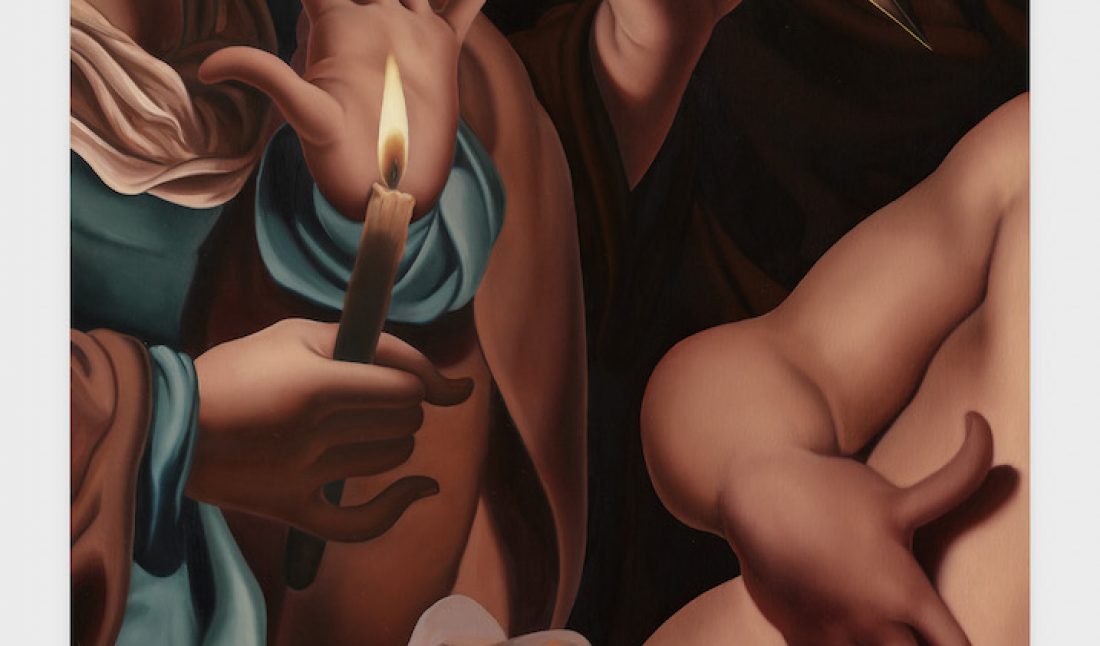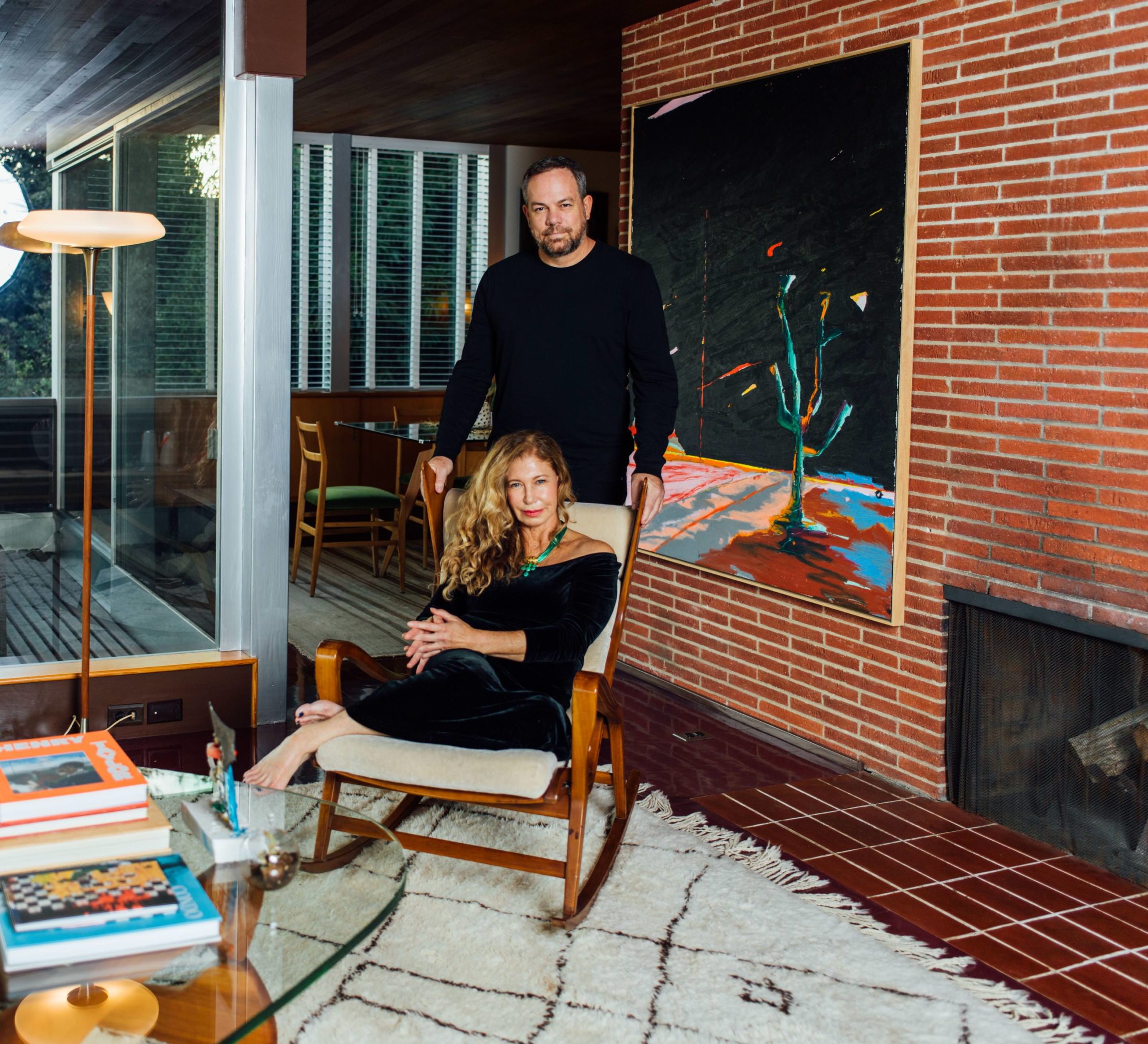Artist Jesse Mockrin’s exhibition “Reliquary” opened last weekend at Night Gallery in Los Angeles. It is her fourth solo presentation with the gallery, featuring vibrant new work that focuses on the evolution and reactivations of Saint Sebastian—a man who survived being shot by arrows, evolving into a symbol of health and vitality. During the time period in the 12th century known as the Black Death, the public looked to “reactivate” relics of the Saint in order to find supernatural guidance. Mockrin references historical paintings of Saint Sebastian and his healer, Saint Irene, while creating her own “reliquary” that connects the not-so-distant past with our own all too familiar experience with sickness and health, life and death.
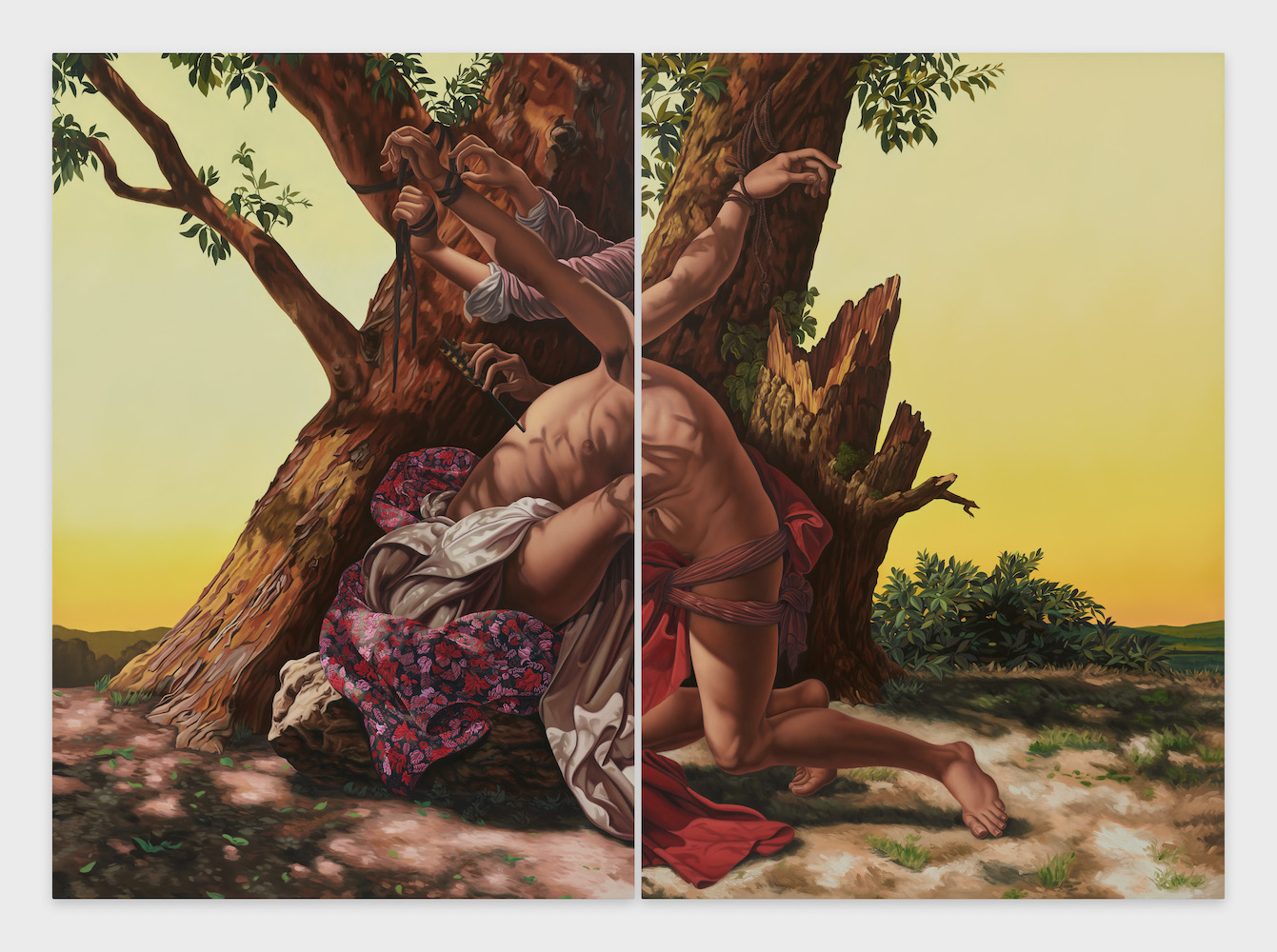 Jesse Mockrin, “Transfiguration,” 2021-22, 90 x 124 in., oil on cotton; photo by Marten Elder, courtesy of the artist and Night Gallery, Los Angeles.
Jesse Mockrin, “Transfiguration,” 2021-22, 90 x 124 in., oil on cotton; photo by Marten Elder, courtesy of the artist and Night Gallery, Los Angeles.
Whitewall was eager to ask the prolific artist about her unique, creative process, the evolution of her transformational diptychs, and introducing Saint Sebastian to the 21st century.
WHITEWALL: What kind of preparation and research did you engage in before creating this new work? What was the starting point?
JESSE MOCKRIN: I often start a show with one idea, and then wind up pivoting in a different direction. In this case, I started out interested in still lifes from the Dutch Golden Age. I have made several paintings that feature animals and dead game, but I have not yet focused an entire show on them. I collected a lot of used books on Dutch still life and made drawings from them. It was during this research stage that I came across images of Saint Sebastian.
WW: How did the subjects of Saint Sebastian and Saint Irene become an inspiration and a focus?
JM: I came across a small black and white reproduction of a stunning painting by Hendrick ter Brugghen from 1625, Saint Sebastian Tended By Irene. I was attracted by the composition of the painting, and also the subject. I was familiar with the historical paintings of Saint Sebastian struck by arrows, but I had not known about Irene. There are many paintings featuring the moment after Sebastian was left for dead and healed by Irene. I started to think I could make a show about Saint Sebastian once I realized there were a variety of representations of him that I could use to explore multiple facets of the story: the gender ambiguity, the pain/pleasure dichotomy, the fragility and resilience of the body, and the shifting meanings of this story over time.
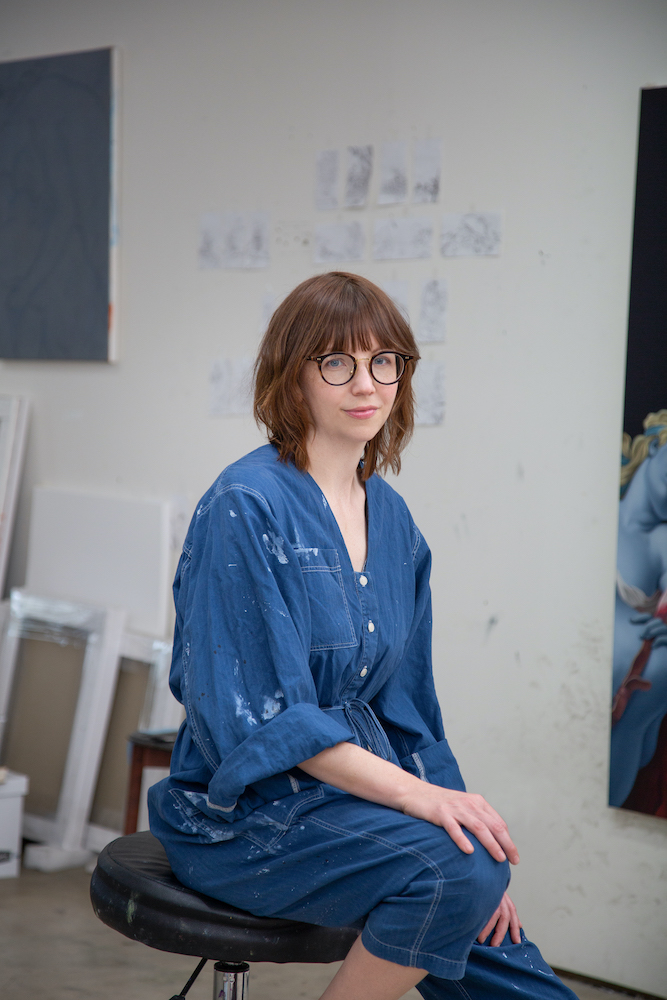 Photo by Nik Massey, courtesy of the artist and Night Gallery, Los Angeles.
Photo by Nik Massey, courtesy of the artist and Night Gallery, Los Angeles.
WW: Can you share how you were influenced by the correlation between Sebastian’s “reactivation” during the Black Death and the current pandemic?
JM: I like to reference European art history in my paintings because the transformation in meaning of these images over time and across contexts is one of the main subjects of my work. Saint Sebastian was originally a Christian martyr, but during the Black Death he became someone to pray to as a savior from plague. Centuries later, he became a queer icon and most recently was recognized as a patron saint of those afflicted during the AIDS epidemic. As we have lived through this coronavirus pandemic, the isolation and the fear of the unknown has linked us to all these other historical moments. That led me to think it was the perfect time to revisit the figure of Saint Sebastian.
WW: In Transfiguration, why have you decided to juxtapose ter Brugghen’s painting of Sebastian and Irene, with François-Xavier Fabre’s Martyrdom of Saint Sebastian?
JM: I started making diptychs in 2017. I have always thought of the edge of the frame as truncating the body in my paintings, but it wasn’t until I put two images next to each other in a diptych that the violence in the cropping became more apparent. While the cropping can be a kind of violation of the borders of the body, the diptych also allows for the building of new bodies across the divide between panels. What interested me about the juxtaposition of the ter Brugghen painting and the one by Fabre was the appearance of symmetry that collapses on closer inspection into a jumble of ambiguous body parts. The figures almost lineup but not quite, which makes the viewing process active – imagining the images together and then apart.
WW: How do you think/hope modern viewers will respond to your reorientation of the history of San Sebastian and Irene?
JM: My hope is that the cropping and recomposing of these subjects shake loose some of the buried content in the imagery of Saint Sebastian. I hope that the androgynous hands in my work, alternately tying down and liberating Sebastian, that threaten here, display tenderness there, show us how easily the meaning of a gesture can be transformed by the context surrounding it.
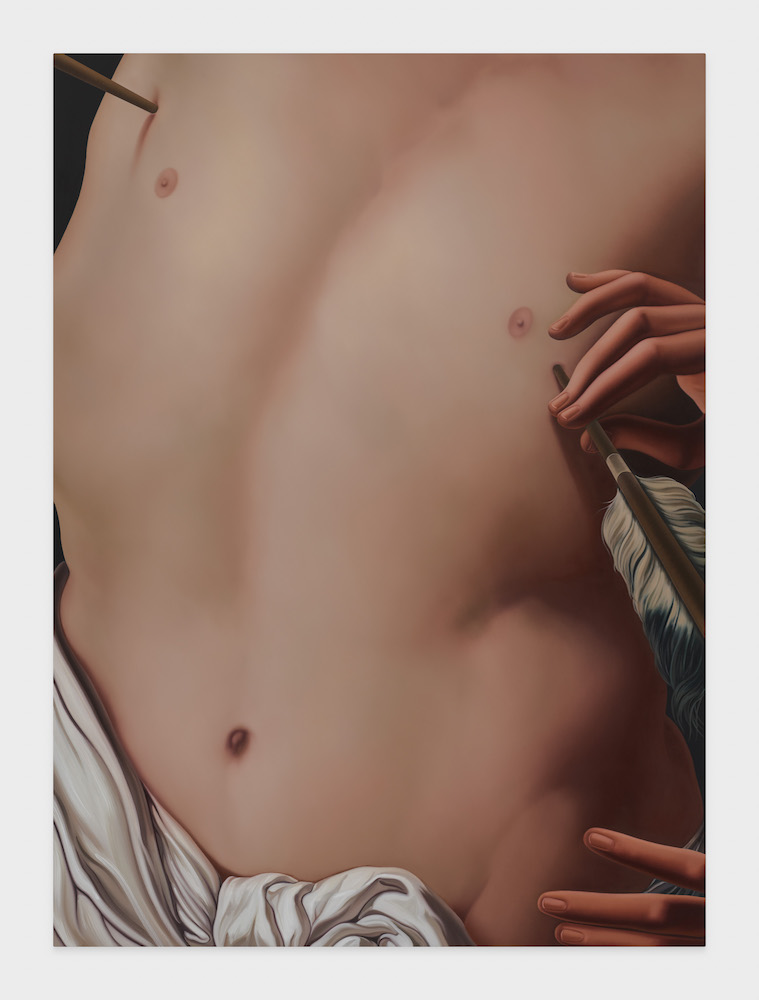 Jesse Mockrin, “Exposed,” 2021-22, 62 x 45 in., oil on cotton; photo by Marten Elder, courtesy of the artist and Night Gallery, Los Angeles.
Jesse Mockrin, “Exposed,” 2021-22, 62 x 45 in., oil on cotton; photo by Marten Elder, courtesy of the artist and Night Gallery, Los Angeles.
WW: How does color and scale come into play in your process?
JM: As Sebastian represents a body on the cusp of the transition between life and death, he is often depicted outdoors at dusk in historical paintings. I expanded on that idea, shifting the time of day by changing the palettes of the paintings throughout the exhibition. One painting has the clear blue sky of a California day; another has a sickly yellow dawn. Some paintings are at night, the palettes dulled down to the more limited range of color you see in the dark. In each case, the choice of light creates the atmosphere in which the figure is seen. In most of the paintings, I kept the scale of the figure uniform to highlight the seriality of the imagery: each figure in the show could be moving from one scene to the next. In two works, I focused the composition solely on the torso and enlarged the scale of the body dramatically. In those works, the body becomes a landscape of exposed, vulnerable flesh.
WW: Can you tell us a bit about your studio and a typical day in your process while working on a new series?
JM: My studio is a mile from my house in Los Angeles, which is incredibly beneficial, considering how time consuming the paintings are, how terrible traffic in this city is, and the fact that I am a mom with two kids at home. I have a storefront studio space in a building with several other artists and art spaces, which makes for a great community. I usually start the day dealing with administrative tasks, and then start mixing paints. I paint in sections – today the fabric, tomorrow the hair, etc. I have to finish the section I start within one day, so it will dry well. I wash brushes at the end of the day and go to sleep thinking about what I’m planning to paint tomorrow.
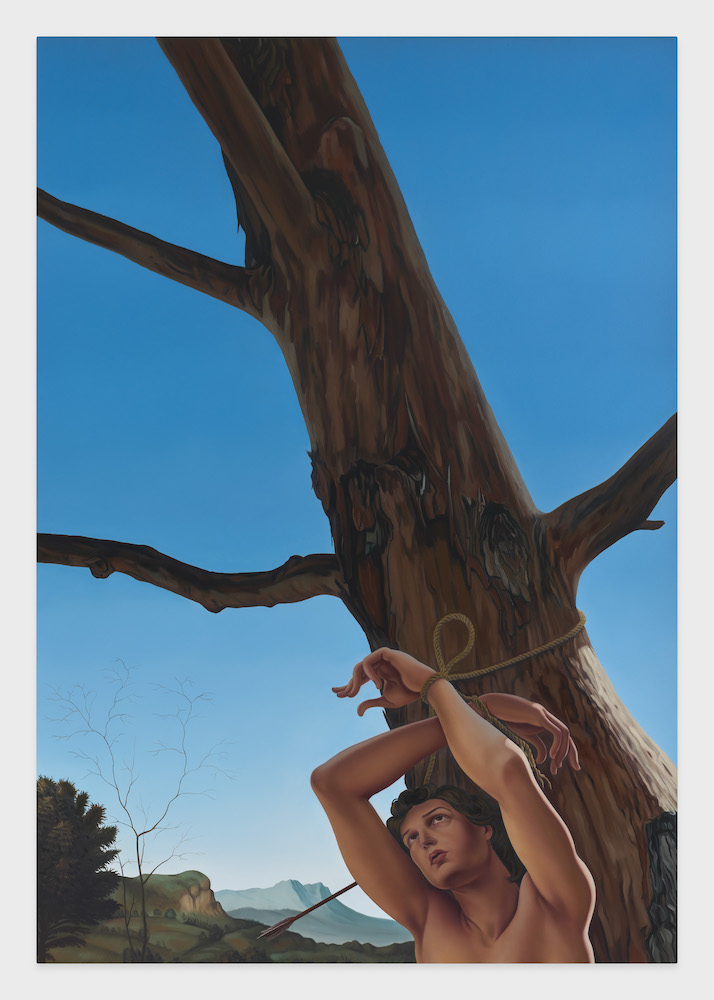 Jesse Mockrin, “Submission,” 2021-22, 90 x 62 in., oil on cotton; photo by Marten Elder, courtesy of the artist and Night Gallery, Los Angeles.
Jesse Mockrin, “Submission,” 2021-22, 90 x 62 in., oil on cotton; photo by Marten Elder, courtesy of the artist and Night Gallery, Los Angeles.






